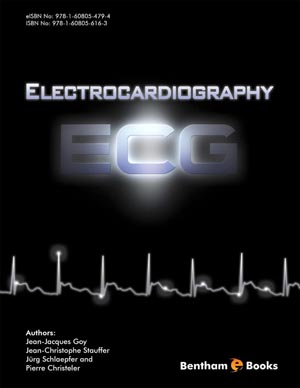Abstract
In this chapter, we address the basic notions of electrophysiology required for the understanding of electrocardiography. Depolarization and repolarization of the cardiac fibers are described extensively. The action potential represents the transmembranar potential changes measured with 2 electrodes during cardiac fiber activation. The 4 phases of the action potential, related to sodium, calcium and potassium transmembranair flow are described. The electrocardiogram (ECG) is obtained by measuring electrical potential between various points of the body using a biomedical instrumentation amplifier. A lead records the electrical signals of the heart from a particular combination of recording electrodes which are placed at specific points on the patient's body. Cardiac activation is a depolarisation, with constant changes in direction and amplitude, recorded by the ECG. Four electrodes with conventional colours are placed on the patient's arms and legs to approximate the signals obtained with buckets of salt water. These 4 electrodes define 6 derivations: 3 bipolar, lead I records a dipole between the left and the right arm, lead II records a dipole between the right arm and the left leg and lead III records the dipole between the left arm and the left leg. There are 3 other unipolar derivations, called augmented (aVR, aVL, aVF), recording the same phenomenon but referenced to a zero reference called Wilson central terminal. To obtain standadized traces 6 unipolar electrodes are placed on the chest at a specific place. Because of their specific position each electrode explores a specific portion of the ventricles: V1 and V2 explore the right ventricle and the high septum, V3 the mid septum, V4 the low septal portion and the left ventricular apex. V5 and V6 explore the medium and lateral part of the left ventricle. Cardiac activation is the sum of all the phenomena of depolarisation and repolarisation of the atrium and the ventricles. The cardiac electrical activity arises from the sinus node, the physiological pacemaker, located at the junction of the superior vena cava and the right atrium; its activity is not visible on the ECG. The main electrical vector is directed from the sinus node towards the A-V node. The atrial activation turns into a P wave on the ECG. From the atrium to the ventricles the depolarisation uses specific conduction pathways. The A-V conduction is the PR or PQ interval. The ventricular activation follows the progression of the depolarisation along the His bundle and activates the ventricles sequentially. It is the QRS complex. The T wave represents ventricular repolarisation. Electrical axis of the P wave and QRS complex has to be calculated and is considered as normal between 0° and 90° for the P wave and between -30° to +90° for the QRS complex. In sinus rhythm, depolarisation is transmitted to the atrium and afterwards to the ventricle. On the surface ECG the consequences are a positive P wave in all derivations except aVR, a constant PR interval and a regular RR interval equal to the PP interval. At rest, the heart rate is around 60 bpm with a slight variation due to respiratory activity. A heart rate < 60 bpm is called bradycardia and a heart rate > 100 bpm is called tachycardia. With high heart rate the P waves are sometimes non visible because they are concealed in the preceding T wave.
Keywords: Cellular depolarization, cellular repolarization, cardiac depolarization, cardiac repolarization, action potential, refractory periods, electrocardiographic electrodes, electrocardiographic derivations, cardiac activation, atrial depolarization, ventricular depolarization.






















